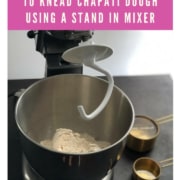Effortless way to knead chapati dough
Note: This post contains affiliate links. As an Amazon Associate I earn from qualifying purchases.
Learn an effortless way to knead the dough using a stand mixer for soft and perfect rotis every time.

What’s your biggest challenge in the kitchen?
The one thing that bogs you down. Makes you feel that you can never get it right, no matter how hard you try!
For me, it was making rotis!
We all know how rotis should be – circular in shape and soft enough so that it can be easily torn apart for dunking into curries.
But getting them right can seem like an insurmountable task. I know you want to give up and are hoping that someone gifts you Rotimatic – the super cool roti making machine. Till that happens, let’s not allow the humble rotis to get the best of us.
How to knead the perfect dough for soft rotis
The secret behind soft chapatis or rotis lies in the dough. The dough should be soft, pliable and should not stick to your fingers when rolling them into circular discs.
If you are kneading by hand, then be prepared to knead for a good 10-15 minutes.
But if you are like me and want a machine to do that for you then there are 2 ways you can get this done using either a stand mixer or a food processor
I prefer using the stand mixer compared to the food processor for the following reasons –
- Easier to clean
- No sharp blades to worry about
- I have limited visuals on the dough during the kneading process with the food processor
- Can do a larger batch in a stand mixer compared to a food processor
In all honesty, the KitchenAid food processor I have is from 2006 and the newer ones may be a lot better at kneading compared to the old model I have.
Can we store chapati dough in the fridge?
Yes, definitely.
- Refrigerator – You can store chapati dough in a refrigerator for a day or two. Anything beyond that, I would recommend freezing them in Ziploc. Thaw for about 30 minutes or microwave for about 10-20 seconds before using.
- Freezer – Don’t forget to divide them into quantities you typically use before separating and storing them in Ziplocs. Thaw it overnight in the refrigerator before use.
How to make perfect rotis
Now that you’ve got your dough nailed, check out this video tutorial to make soft and perfectly puffed up rotis.
Tips for a perfect chapati dough
- Amount of water – I always make the dough using the stand mixer and I’ve always noticed that the amount of water varies depending on the wheat flour used. I use anywhere between 1.25 cups to 2 cups of water for 3 cups of flour. That’s why I suggest doing it in small increments – add a cup of water in the beginning and then add in increments of 1/4 cup to a few tablespoons depending on how dry or wet your dough seems to be.
- Speed setting – Keep it between 2-4 or low settings to avoid splattering of flour.
- Make sure the dough is soft enough that it leaves an impression when you press your finger against the dough.
- Cover the dough and let it rest for at least 20-30 minutes for super soft rotis.
Watch below how to knead chapati dough using a stand mixer

Knead chapati dough using a stand mixer
Ingredients
Instructions
Making the dough using a stand-in mixer:
- In a mixing bowl of a stand mixer, add 3 cups of wheat flour.
- Use a dough hook and start kneading using the hook attachment. Set it up at the lowest setting possible. Add salt, a tablespoon of oil with 1/2 cup of water. Add water in small increments and continue to knead till the dough comes together as a ball.
- Add a tablespoon of oil to the dough and knead till the oil is absorbed.
- If the dough is sticky, sprinkle approximately 1/4 teaspoon wheat flour (or more if needed) on the dough and knead again to form a dough that is not sticky. The dough should be supple and soft.
- Cover the dough and set aside for 15-20 minutes.
Video
Notes
- Amount of water - I always make the dough using the stand mixer and I've always noticed that the amount of water varies depending on the wheat flour used. I use anywhere between 1.25 cups to 2 cups of water. That's why I suggest doing it in small increments - add a cup of water in the beginning and then add in increments of 1/4 cup to a few tablespoons depending on how dry or wet your dough seems to be.
- Speed setting - Keep it between 2-4 or low settings to avoid splattering of flour.
- You can use ghee instead of oil.
Disclaimer: Approximate nutritional information is provided as a courtesy and can vary depending on the exact ingredients/brands used. If you have health issues, please work with a registered dietician or nutritionist.

